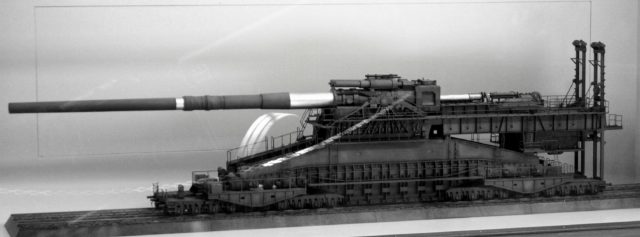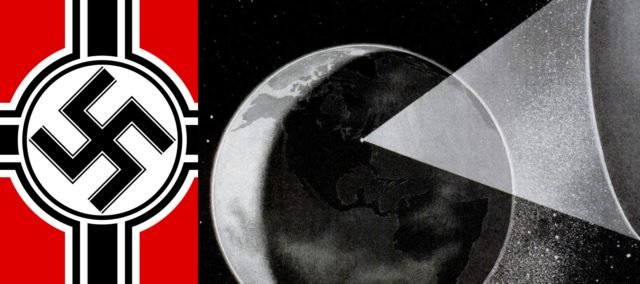During WWII, scientists and inventors on both sides of the conflict raced to develop new and terrifying weapons that might tilt the balance in their favor. Many new war machines were created and put into practice on battlefields across the world.
However, the Nazi regime had a particular talent for thinking outside the box; so far outside of it that many of their ideas were utterly impractical. From death-rays in space to whirlwind guns, here are five far-fetched weapons the Germans tried to implement.
Schwerer Gustav
The largest cannon ever created and deployed in the history of human warfare, this behemoth of a weapon could fire projectiles at a range of 29 miles. Each shell was nearly as large as a regular tank. It ran on railway tracks and weighed roughly 1350 tons. Its name translates as the Great Gustav.
In theory, the cannon was a terrifying prospect. In production, it must have seemed like the ultimate game-changer against the Allied forces. In practice, however, the Great Gustav proved to be almost entirely useless. Its size and weight were impractical. A small army of workers was required to assemble the weapon and lay out the necessary railway tracks.

This terrifying war machine was more of a hindrance to the Nazis than a threat to their enemies. It saw minimal action and was subsequently relegated to the history books as a waste of time and effort.
It was so huge that is needed a special contraption to move it – the Landkreuzer P. 1500 Monster
Landkreuzer P. 1500 Monster
Adolf Hitler was a believer in what has been described as “war-winning weapons” – new and innovative weapons that turn the tide of the war. In this spirit, he commissioned the development and construction of a truly massive war machine, known as the Great Gustav. This massive gun was originally designed to move on a train line, but as that required an enormous amount of manpower, the Landkreuzer P. 1500 Monster was proposed as a solution.
A self-propelled contraption, it was intended to make the Great Gustav more mobile. A machine of that size was inevitably set to hit some practical and functional snags. For one thing, its size made it something of a strategic liability. Its sheer heaviness would destroy roads and bridges, and it could not be transported by rail for the same reason. In the end, the production of this monster was put on hold.
Whirlwind Cannon
When it comes to the Whirlwind Cannon, the name says it all. This weapon was designed by eccentric Austrian engineer Mario Zippermayr.
It created a swirling blast of air that could shoot upwards, destroying planes in mid-air. Early prototypes seemed to be very effective, hitting targets at a distance of 600 feet. Had the weapon worked on a larger scale it could have been a formidable new threat to Allied fighter planes, but it proved to be wholly inadequate. A full-scale model was constructed and tested at Hillersleben Artillery proving ground, but it could not fire blasts intense enough to reach the altitude at which enemy planes flew. After several unsuccessful trials, this remarkable weapon was scrapped, and the test model abandoned.
Goliath Tracked Mine
While its name may conjure up images of a giant, the Goliath Tracked Mine was a remarkably small device. It was a simple concept; a bomb on caterpillar tracks that could be controlled from afar with a joystick. The idea was to have German forces drive them towards enemy lines and detonate them when in range, without putting their own lives at risk.
Like so many of the Nazi’s outlandish inventions, it only worked in theory. The critical flaw in its design was the remote control element; to function, an extended cable had to stretch from the joystick to the tank. All the Allied troops needed to do to disable the device was cut the wire, at which point German troops could no longer steer or detonate the bomb. They were also extremely vulnerable to anti-tank weaponry, impractically slow on the battlefield and overly expensive to produce.
Sun Gun
One of the most outrageously unrealistic weapons proposed and developed by German scientists during WWII, the so-called Sun Gun is pure science-fiction.
The basic concept involved constructing and launching a space station into orbit that would be able to reflect the light of the sun back onto earth in intensely controlled rays. Theoretically, this would allow the Nazis to destroy entire cities in an instant, but “theoretically” really is the key word here.
Although early tests were run and miniature prototypes built, even the Nazi scientists behind the concept admitted it would take anything from 50 to 100 years to put their work into practice. To harness the sun’s light as a weapon, they believed they would need nine square kilometers of metallic sodium, suspended almost 10,000 kilometers above the earth’s surface. Symptomatic of the Nazis’ many far-fetched ideas for super-weapons, there was no future in this particular venture.


Leave a Comment